The easiest speed and biggest smiles you can have on a cruising yacht? Toby Hodges is stunned, sailing the Dragonfly 36 over two days
Dragonfly 36 review: Probably the most fun boat ever!
Tuesday 12 May 2025 in Skaerbaek, Denmark, was a special day, a defining moment in my sailing career. I’m normally deliberately objective when testing, but I admit to really falling for this quirky winged beast – in that fresh phase, infatuated sort of way.
I fully accept a rapid cruising trimaran won’t suit everyone, and I’ll list the reasons why. But, after two exceptional days spent aboard, I also feel confident in highlighting the many reasons why this is the most successful new yacht this year – with 28 ordered before this first one launched!
Dragonfly has been building trimarans near Kolding since 1967 and remains a Quorning family-run yard. Its new 36 marries modern design and engineering ingenuity, including buoyant, wave-piercing bows and all-composite folding mechanisms for the floats. Chiefly, as we were to discover, it’s a super-light cruiser with serious gas.
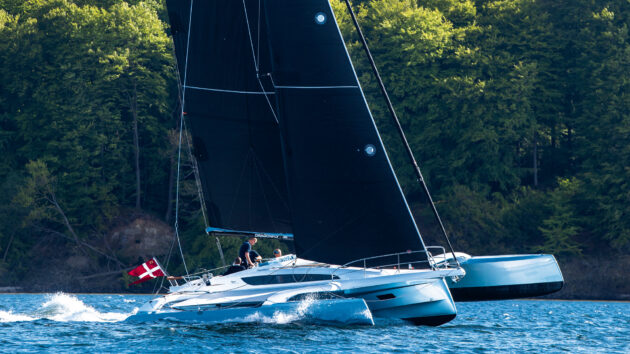
‘It’s a superlight cruiser with serious gas’. Photo: Richard Langdon
Within boat lengths of the small fishing village and marina of Skaerbaek, where Dragonflys are towed down the hill and launched, we hoisted (a lot of) main and code sail, bore off onto a reach and took off. Life became instantly smooth and quiet as we lifted straight onto the plane.
Helming from right aft, within the curved embrace of the cushioned pushpit, Dragonlet and I had no slow, awkward dates getting to know each other, rather an absolute and instant engaging connection.
Article continues below…
In the 12-15 knot puffy breeze, we gybed around the fjords under Code 0 as if aboard a dinghy. Our speeds averaged in the low teens, shooting up to 15-17 knots in the puffs (at 55° apparent). It offers non-stop planing on most angles, particularly when sailing anywhere slightly off the breeze in 12-plus knots. So much so that you really notice it when you’re (rarely) not, because it seems comparatively noisy as the wake catches up with the hull.
Steering is easy, direct, engaging and enjoyable. It offers a proper sportsboat feel on a 36ft cruising yacht. I couldn’t help thinking that if you put any performance monohull enthusiast onto the helm during that first sailing session, they’d sign up for one there and then. It’s that good.

The 36 sails even faster than it looks – both off the wind and beating. Photo: Richard Langdon
Afterburners ignited
With the large blue asymmetric hoisted, the Dragonfly 36 comfortably maintained a long-legged average stride in the low teens, before the log would shoot up to match the 17-20 knot gusts. That acceleration is intoxicating, but it’s also combined with arguably an even more impressive quality: stability. During bear aways, I’d expect the leeward bow to bury, but instead the forward volume in those floats performs wonders, simply converting it to yet more easy speed.
How? This is the first Dragonfly with an inverted bow on the main hull. Together with the wave-piercing bows on the outriggers, this provides formidable buoyancy forward. These asymmetric-shaped floats, which have their widest sections at the waterline, are also 70cm further forward than the main hull to increase directional stability and help you push it downwind. The result is the 36 just lets you throw it around without complaint.
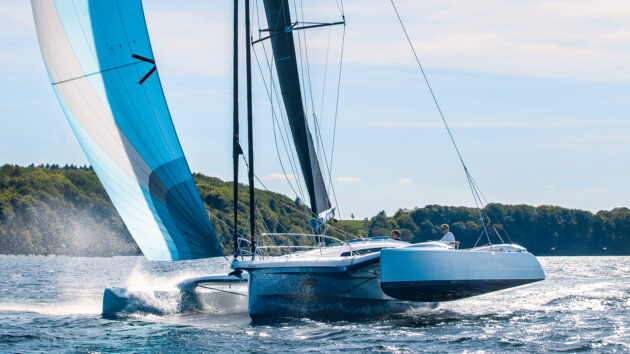
Blast reaching spikes the adrenaline while tacking through the Danish fjord’s shallows is addictive. Photo: Richard Langdon
With your foot to the floor, a 30ft stream of whitewater hoses away from the transoms, as if a jet boat. Our top speed was clocked at 20.5 knots – on flat water in similar wind! Dragonfly’s CEO and mastermind, Jens Quorning, says they measure performance not by the speedo, but by the size of your grin when sailing. My dial was firmly in the red.
We carried that spinnaker down through a tight fjord, with a stunning tree-lined backdrop, gybing back and forth yards from the shoreline. Dragonflys are designed to sail short-handed and, on the 36, the two powered winches each side are within reach of the helm. So although we didn’t need four aboard, and it made the cockpit feel a little cramped in the corners at times, it helped get the most out of the boat (despite their thousands of hours of Dragonfly trials, the Quornings and long-term UK agent, Al Wood, still thrive on sailing these yachts).
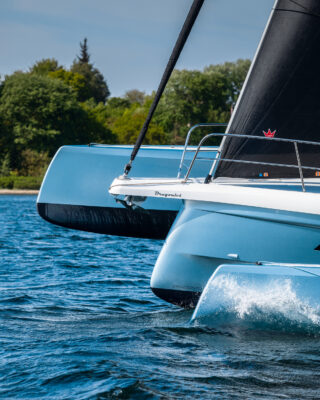
Inverted bows provide telling stability. Photo: Richard Langdon
Making wind
Another joy of a performance trimaran is that it can provide similar sensations to those of a monohull sailing upwind. In the Dragonfly’s case, you get plenty of reward from a single carbon rudder blade, so with the windward hull airborne and minimal wetted surface, flat water beating is fun.
Little active trimming is necessary and you can still steer with a drink in hand. The 36 felt particularly well balanced close-hauled on starboard tack, when I could leave the wheel and it kept tracking true, but it needed a light guiding hand on port. Dragonfly believe this may be a centreplate alignment issue, which it is trying to resolve.
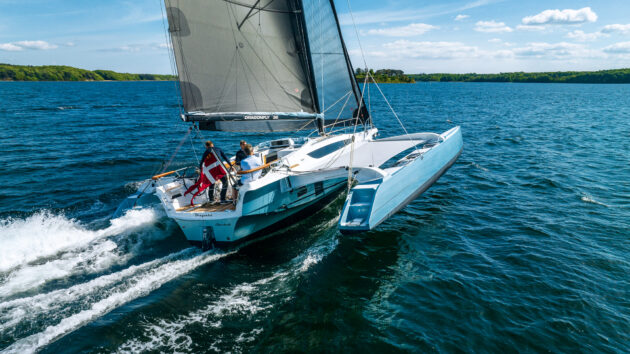
The mid freeboard chine from the bow deflects spray and preserves some forward cabin volume over the narrow waterline beam. Photo: Richard Langdon
During our second day we saw how the 36 performed in the lighter breeze. Again it showed pace, particularly when pointing, clocking 8.5 knots at 40° to a true wind averaging 7-13 knots. These are performance monohull figures, helped by the narrow hulls, centreboard, inboard genoa tracks and rotating carbon mast. We also matched up against Jens’ son Peter, who solo sailed an all-carbon 40 Performance, and it was interesting to see very little difference in pace. Both boats easily exceeded the true breeze under Code 0s (8.5 knots in 7 true at 45°A).
The 36 is a wind generator, a craft that will match or outpace true windspeeds, all the way from 5 knots to nearly 20. Polars show it topping out at around 24 knots – in flat water. Granted, you don’t get to see what it’s like in waves or even surf in these confined waters, but you get to feel the 36 react to every lift, while executing plenty of manoeuvres.

A tasteful if conservative finish with space used intelligently. The saloon has long benches, with the portside converting to a berth, while the forward cabin is reached through a thick bulkhead, with a sliding panel for privacy. Photo: Richard Langdon
In fact, it was as we short-tacked our way up another fjord into the setting sun on our first evening, when it all sank in for me. I had the cockpit to myself, the heated foam-decked helm seats warming my glutes – a delightfully novel way to counteract the first chill of the evening air – and I couldn’t help but marvel at the sheer pleasure this yacht provides. We were to moor up at the formidable converted sanatorium near Kolding that night (see page 75), a unique spot, yet still I didn’t want to tear myself from the helm.
This was perhaps the most enjoyable sail trial I’ve done in over two decades – an incredible day.
Once the Dragonfly is at rest you begin to appreciate it’s not simply a fairground ride, but a complex marriage of design and composite engineering.
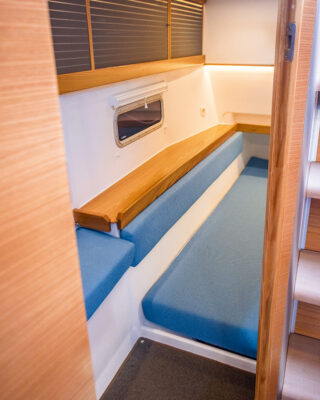
Aft cabin has wide berth but lacks stowage. Photo: Richard Langdon
Engineering evolution
Much of this revolves around the Swing Wing system, employed as we approached the jetty. Floats that fold into the hull provide the convenience of monohull berthing, using a system which has principally remained the same since Jens and his father Borge developed it in the late 1980s. Operated using the winches and without leaving the cockpit, a continuous line system pulls the floats in or out while tensioning or stowing the trampolines. The operation took us approximately one minute.
However, when you consider the complexity involved, both in the loads it places on the hull connections and how to support the mast, you realise it’s anything but simple. Despite having a beam join designed for 25 tonnes of compression, this 36 marks the first time Dragonfly has used composite here as opposed to stainless steel connections. “It was a 10-year dream to do this but we didn’t have the courage!” Quorning explains, with the result saving time, weight and cost.
As the outriggers fold forwards, they lift the main hull and increase overall length, with beam reducing from 8.12m to just 3.7m. You also have to consider the rig – using a deck-stepped rotating mast on floats that fold demands creativity. The yard has used tall carbon masts as standard since the early 1990s, which have incredibly strong and light round profiles designed to suit this Swing Wing system. The running backstay-style split supports can be tensioned with floats folded or extended.
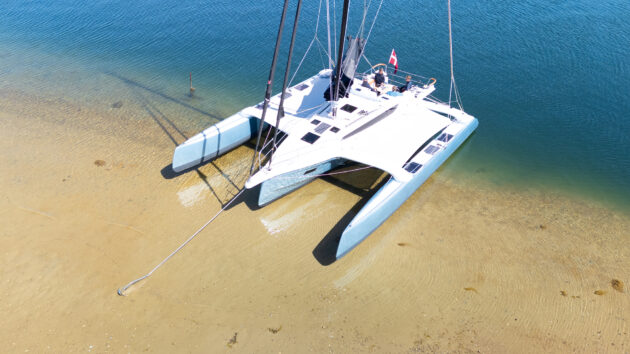
The joys of shoal draught. Photo: Richard Langdon
The test boat was set up with two deep reefs using 3:1 thimble purchases on the mainsail leech, which crank the sail down and aft via the winch to maintain sail shape without anyone needing to leave the cockpit. Dragonfly ensures its models can be sailed solo, proving so by winning events such as the Silver Rudder Race around Denmark. All running rigging is led cleanly underdeck to the powered Andersen winches in reach of the helm.
A boom vang on a block and tackle is used on either side/tack instead of a traveller, doubling as a preventer and helping to free up cockpit space. The test boat sported Elvstrom’s new Xylo sailcloth, a performance filament carbon tape for enhanced shape, while for offwind sailing, many owners chose a Code sail as it can be left hoisted. Dragonflys can sail wing on wing with this and the main, tacking it to the windward float and using a barber that runs from midships to the bow.
The snub bowsprit houses the Code furler, is sturdy enough to use as a step for bows-to mooring and keeps the anchor chain clear of the reverse stem.
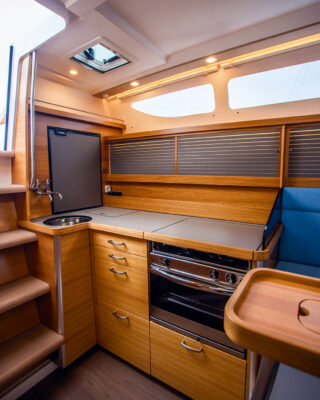
The Dragonfly 36 has a reasonable-sized workable galley. Photo: Richard Langdon
Beach parking
Another feature Dragonfly has employed for decades is the use of a lifting centreboard on the central hull to prevent leeway. The 80kg foam sandwich board flips up in the case of grounding, via a spring-loaded camcleat by the winches (yes, we ‘tested’ it). This was another feature which took years to design and refine, particularly the panel closure beneath the hull.
The rudder also kicks-up and has a similar safety fuse cleat. Shaped in hollow prepreg by carbon maestro Marstrom for an ultra-light feel, its unusual curved profile is designed to prevent cavitation at high speeds.
The sail drive is mounted right aft, between the dual helms, to allow for beaching – not ideal for weight management, but it also keeps noise and heat out of the interior and preserves maximum interior space.
Accommodation
You’ve had the sailing thrills to dream about, and have now found that isolated beach for the night. Can the 36 offer enough for ‘comfortable’ cruising too?
Yes… as long as you appreciate the compromises real speed necessitates. And that doesn’t mean stark minimalism, indeed the 36 has a warm interior lined with hand-built joinery (elm veneers as we had, or lighter ash). However there’s no getting around the fact this is compact living for a premium-priced 36-footer.
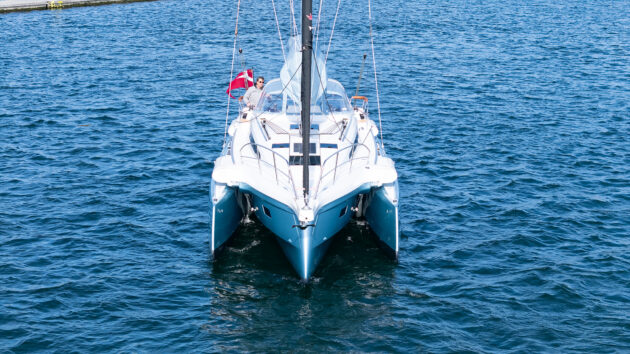
The 36’s new composite folding mechanisms. Photo: Richard Langdon
There are no layout options, as the centreboard trunk and bulkheads are immovable. Instead, owners can only play with the colours and upholstery – but do get 2m headroom and space to sleep six. The saloon has long benches, lots of natural light, ventilation and stowage.
It’s also an adaptable area, with a small standing desk and switch panel, and the port settee doubling as a kid’s den or passage berth. The table leaves fold up or down to allow six to eight to sit while providing clear access forward.
The aft cabin extends under the cockpit, providing enough seated headroom height to make it feel spacious and comfortable, though stowage is an issue. There are outboard lockers each side, but you won’t be hanging blazers and cocktail dresses in here.
Indeed, the double locker opposite the heads is the only hanging space and even that’s only half-height. The heads is compact – a small, practical wet heads area where you’d sit on the toilet to shower. Meanwhile having to climb through a ring fame to access the forward cabin obviously won’t suit all, but you do get a comfortable 2m x 1.6m berth once in.
Vinylester and divinycell with carbon reinforcement is used for these main bulkheads, while closed-cell foam cored construction ensures Dragonflys are unsinkable. Meanwhile, four stainless steel deck eyes enables the Dragonfly to be easily craned out of the water anywhere.
Dragonfly 36 specifications
LOA sailing: 11.55m / 37ft 11in
LOA folded: 13.43m / 44ft 1in
LWL: 10.90m / 35ft 9in
Beam sailing: 8.12m / 26ft 8in
Beam folded: 3.70m / 12ft 2in
Draught: 2.00m-0.67m / 6ft 7in-2ft 2in
Disp (lightship): 4,500kg / 9,921lb
Berths: 6
Engine: 30hp 21kW saildrive
Water: 220lt 48gal
Fuel: 70lt 15gal
Sail area/disp ratio: 32.8
Disp/LWL ratio: 97
Price: (ex VAT) Touring from €554,000; Performance from €582,000; test boat €809,445.
 If you enjoyed this….
If you enjoyed this….
Yachting World is the world’s leading magazine for bluewater cruisers and offshore sailors. Every month we have inspirational adventures and practical features to help you realise your sailing dreams.Build your knowledge with a subscription delivered to your door. See our latest offers and save at least 30% off the cover price.
Note: We may earn a commission when you buy through links on our site, at no extra cost to you. This doesn’t affect our editorial independence.
Verdict
I’m sure I’m not alone in thinking Dragonflys are (frustratingly) expensive. But seeing the engineering, design and composite solutions required to ensure a stiff, rewarding and durable product explains things somewhat. Where its smaller models represent pure sportsboat fun, and its 40 is a serious step up in size and cost, the Dragonfly 36 takes on the best of all features and adds its own trump: the handling stability when powered up. Downsides are few – that compact interior – but you can balance that against positives such as its ability to fit in a regular berth, embarrass any other yacht around, and take the shallowest spots in an anchorage or dry out. No, it might not suit ocean passagemaking, or have the tanks or stowage for long-term cruising. However, if your prime reason for going afloat is for the enjoyment of sailing... the DF36 is relatively priceless. The lightest racing monohulls can barely compete, no cruising yacht of this size comes close in speed. In fact, for any left still wondering about value for money, consider this: a competent sailor or two could sail it to a regatta and outpace a fully crewed maxi! After testing hundreds of yachts, this one really shines out for me. The trouble is, by telling you this I may just have made the lengthy queue for one even longer.




